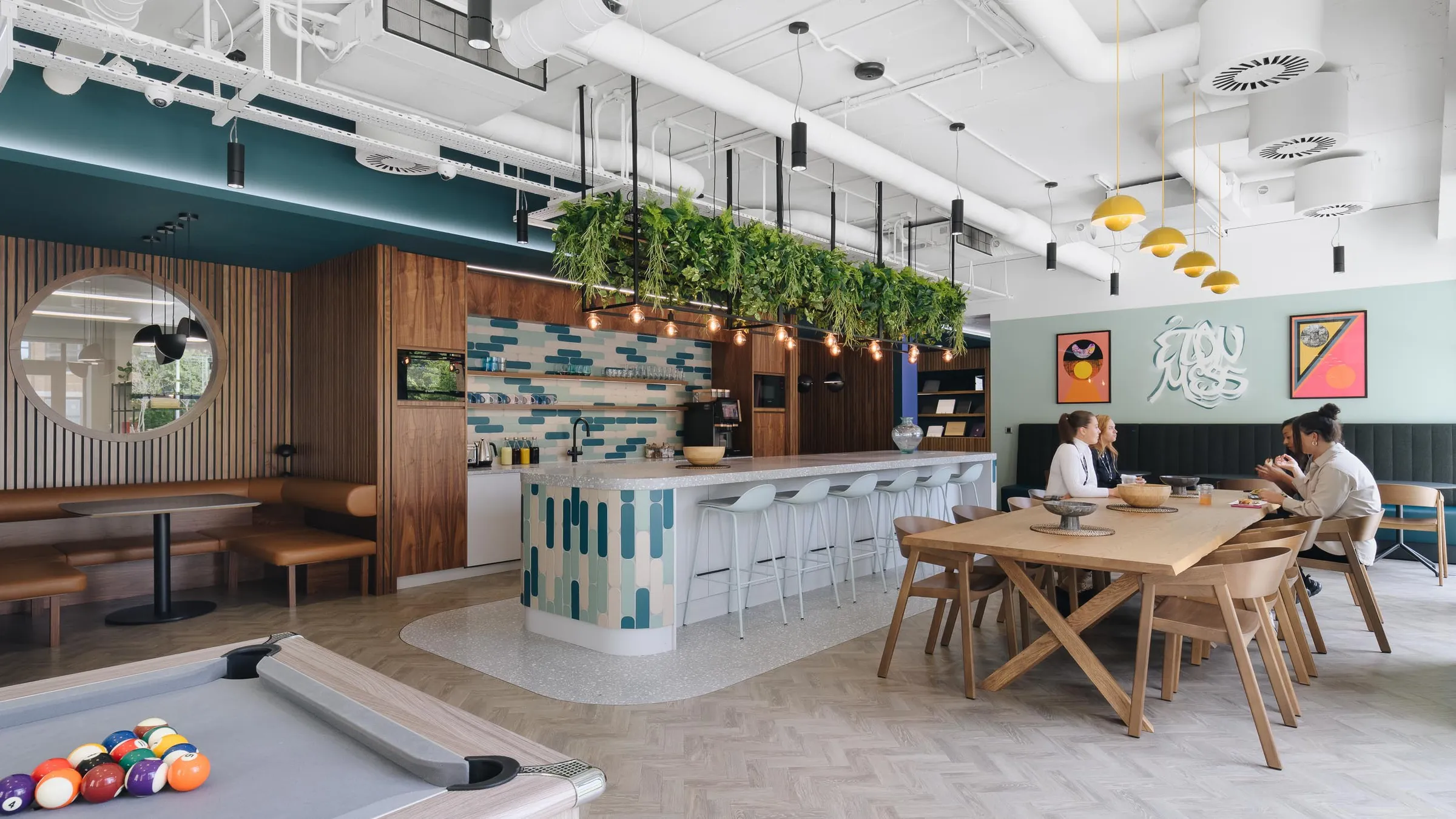Trends in Flexible Workspace Design
No matter where you work, the environment has a significant impact on your productivity, wellbeing, and ability to meet KPIs and reach goals. In this article, we’re taking a closer look at the facts and figures behind the flexible workplace design trends of today.
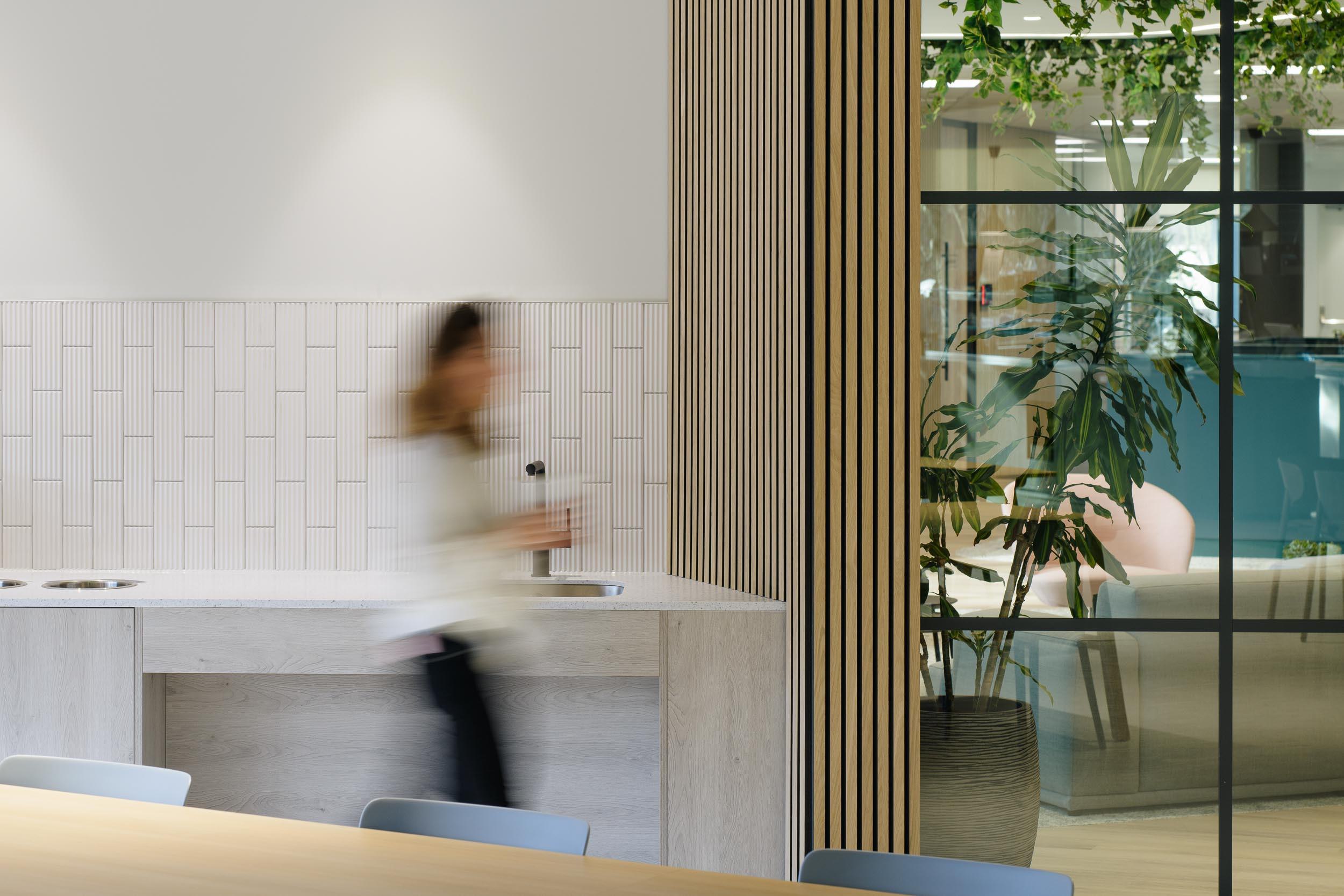

Written by
Fritha Selwyn Jones
Contents
Pre-pandemic, the world was regulated by commuting to the office for work, working with your teammates together and then coming home. We never knew what would hit us in 2020 when the world ground to a halt and demanded us to adapt to new ways of working that many of us had never tried before.
No matter where you work, the environment has a significant impact on your productivity, wellbeing, and ability to meet KPIs and reach goals. In this article, we’re taking a closer look at the facts and figures behind the flexible workplace design trends of today.
Flexible Working and The Covid Pandemic
In January of 2020, just 5.7% of us worked from home. By April, that number was 43%, with 1.93 million people in coworking spaces worldwide.
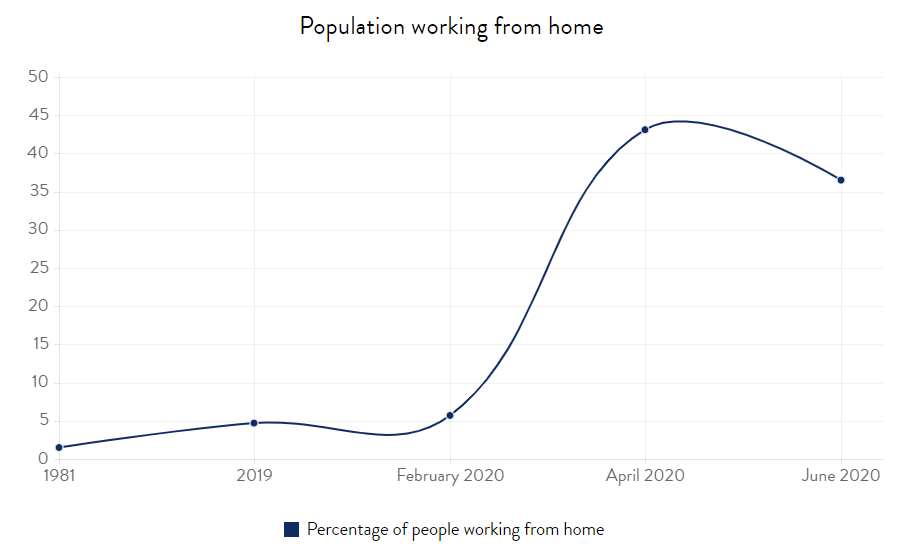
Image source: thehomeofficelife.com
We’ve come a long way since the days of lockdown, and now many businesses have adopted flexible working, seeing the merits of allowing employees more freedom with how they show up to work.
A 2021 report on lessons learned from flexible working asked employers what direction they planned to take with regard to flexible working:
63% surveyed planned to expand hybrid working post-pandemic, with 81% already practicing hybrid working to an extent and 19% never having tried it.
Pre-pandemic, 17% of employers engaged their workforce in hybrid working, which increased to 50% post-pandemic.
Those expected to do no hybrid work pre-pandemic were at 25%, but since the pandemic, that number has decreased to 16%.
45% of those surveyed intended to expand or introduce full-time homeworking at the time of the report while 31% anticipated more than half of their entire workforce will totally work from home.
- Planning measures to facilitate working from home saw these percentages:
45% will change policy.
41% will invest in the quality of technology.
35% will invest in the quantity of technology.
33% will provide online guidance.
Only 28% plan to implement manager training in remote working.
In 2022, 14% of people worked from home exclusively, while 24% worked from home and travelled to work.
According to a Forbes article on remote and hybrid hiring, in 2023, businesses with completely flexible remote work policies grew in headcount by 1.9% in the second annual quarter. Businesses with structured hybrid policies (in-office 1–4 days a week) grew in headcount by 1.5% in the second annual quarter.
Flexible Workplace Behaviour Worldwide
The global market for flexible workspaces is booming. According to market analysis, in 2022, it was valued at $43.23 billion. It’s growing at a capital annual growth rate (CAGR) of 11.87% from 2022 to 2023. By 2023, the global flexible workspace market will reach £123.67 billion as businesses and entrepreneurs continue to see the value of flexible working. Of all regions, Pacific Asia is expected to grow the fastest due to the increasing number of small enterprises and freelancers in that region.
As of 2022, Europe is the world region with the most flexible workspaces, at approximately 4,169, with Asia coming in at an incredibly close second with 4,137. The chart below shows the dispersion of flexible workspaces by world region.
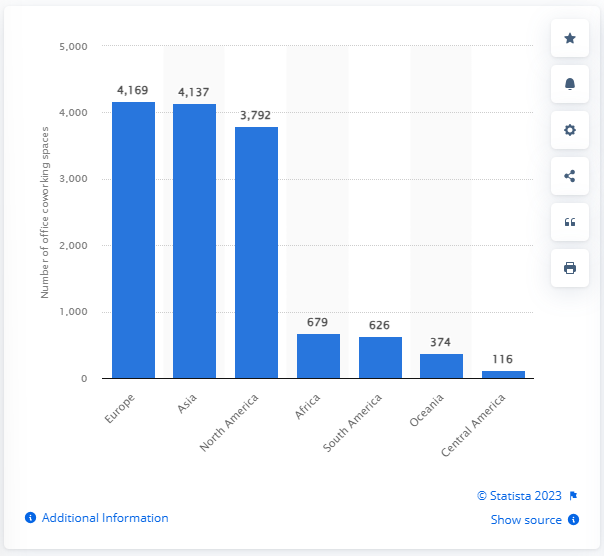
Image source: statista.com
Key players in the flexible workspace world are WeWork, Workspace, Awfis, SMARTWORKS, BizSpace, Servcorp, IWG, Garage Society, The Great Room, Pacific Workplaces
Increasing adoption of technology and innovation in digital ways of working were significant drivers for further expansion of the flexible working market. As was a surge in self-employment, and freelancer industry growth. Multinational companies also demanded more flexible offices.
Flexible Workspaces and Productivity
Research by Savills on how flexible working affects productivity revealed how the UK office layout and new working models have impacted employees. Their findings were:
19% of participants preferred to work from home, with the majority surveyed (54%) saying they preferred flexible working. ⅓ of participants do not think their companies possess the right technology to allow them to work flexibly.
Open-plan office layouts have become more commonplace over the last decade.
45% of workers thought hotdesking reduced their productivity, and just 12% thought it increased their productivity (the lowest rate in Europe). 60% preferred the familiarity of a desk that was permanently theirs, and only 3% favoured a shared desk.
See the table below, which shows the perceived increase or decrease in productivity based on the floor plan of the workspace.
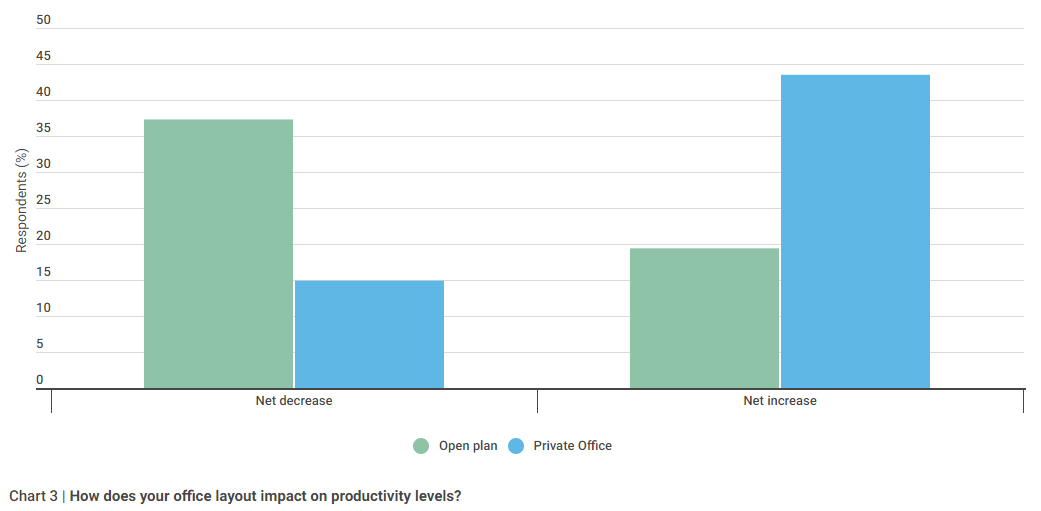
Image source: savills.co.uk
This graph shows the number of open-plan vs private offices by city in the UK.
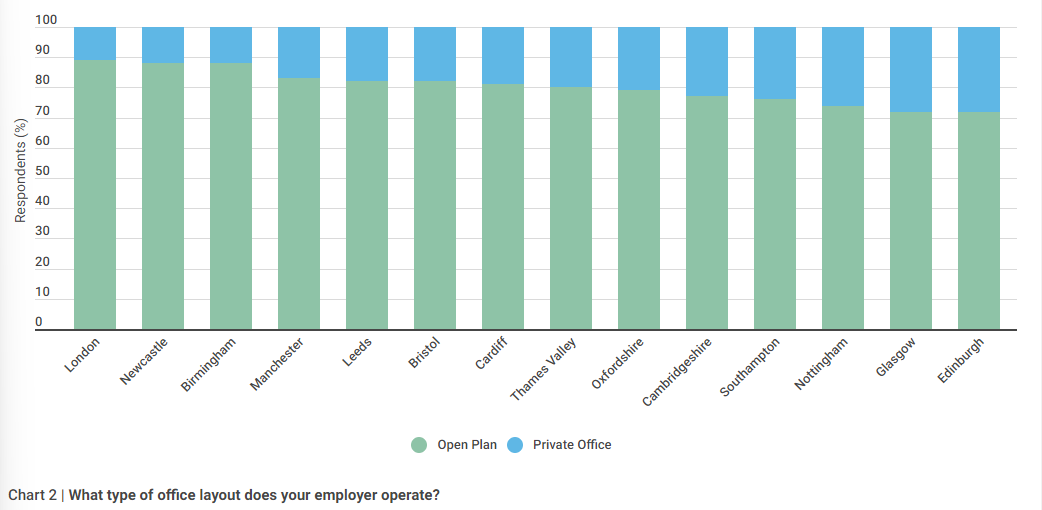
Image source: savills.co.uk
The pie chart below shows the environments in which participants in the Savills survey said they preferred to work.
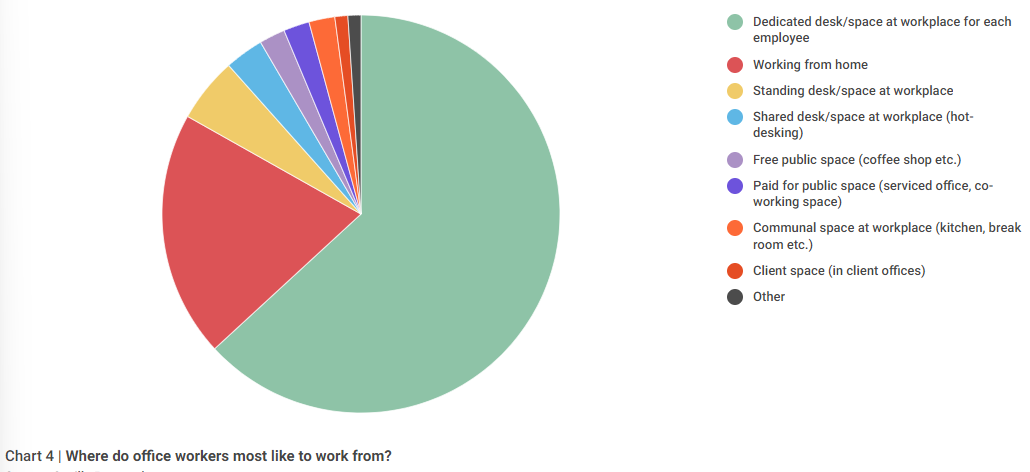
Image source: savills.co.uk
In the chart above, 19% of those surveyed said they preferred to work from home. What are some of the benefits people get from working from home?
55% say they focus better when working at home.
80% can accomplish all their tasks remotely.
33% cite the savings they make working from home as a big benefit.
34% said they can look after pets, children, and ageing relatives more easily.
25% cite improved health (physical, mental, and/or spiritual) as a benefit.
18% enjoyed the freedom to travel and relocate that remote working afforded them.
Those most likely to work from home are high earners. 38% of workers earning £40,000 or above hybrid worked during the survey period in 2022. But only 8% earning up to £15,000 reported the same. This is likely due not only to space and resources at home making work more comfortable but types of jobs that allow working from home.
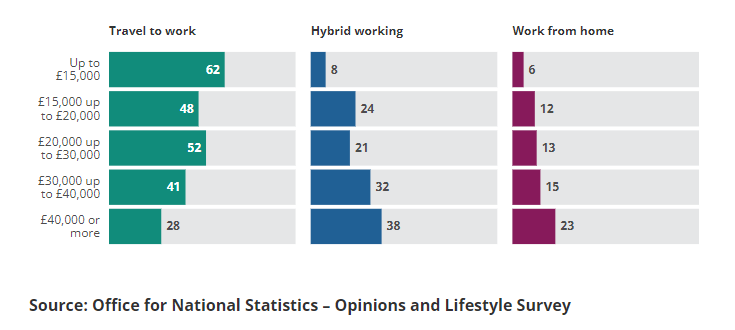
Image source: ons.co.uk
There are some downsides, too, though.
60% reported feeling less connected with colleagues.
30% found it difficult to separate their work lives from their home lives.
Surveyed workers said the biggest challenge when working from home was the struggle to ‘unplug’ and the difficulties in collaboration.
The Adoption of Flexible Workspace Designs
In 2019, Gensler and the British Council of Offices (BCO) together investigated flexible workspaces in the corporate sector in the UK, finding that 40% of those using flexible work spaces would rather work in conventional office space. So, what design factors play into how flexible and conventional workspaces are perceived and the effect they have on work?
With more companies providing coworking areas to their staff, collaborative and shared spaces were rated as the best types of workspaces in the study. 69% agreed their workplace helped them collaborate more with coworkers, and 57% reported being happier using flexible workspaces. However, just 29% felt flexible workspaces contributed to increased efficiency.
Gensler and the BCO determined that flexible workspaces needed to address both personal preferences and a range of different work settings, particularly those that offered more privacy than open-plan offices.
It was noted that companies adopt flexible workspaces to transform business processes, pull pace with industry trends, and foster collaborations, employing at least one of these five models:
“Individual membership to a coworking space
External agile project space
Private office space in a coworking area
Flexible space in the company’s office
Alliance with a service provider.”
The report concluded with the following predictions about future flexible workplace trends:
“The future workplace will be more of a service and experience than a product.
Data will play a huge role in bringing together experience, space, and social dynamics contributing towards productivity
There will be a rise in hospitality-driven workplaces that prioritise amenities and convenience
The workplace will be seen as a place for up-skilling and creative problem-solving
Given the ongoing geopolitical shifts, there will be a rise in globally connected flex spaces as a wider platform of touchpoints that allow corporations to have a presence in new markets without setting up a base.”
The Design of Coworking Spaces
According to the Global Coworking Survey, 400% of coworking spaces are profitable though very few break even in the first few months of opening. Let’s look at some design factors that play into coworking spaces, according to Drop Desk:
60% of global coworking space users use assigned seats. The use of meeting rooms is at 30%.
On average, coworking spaces reserve 50% of their space for open-plan desk space and 25% for meeting rooms, break areas, and amenities.
51% of spaces have private areas for calls and remote meetings.
58% of spaces are furnished with modular walls and configurable layouts.
Over 75% of spaces have a central hub for meetings and gatherings.
60% feature biophilic elements, including plant life, natural lighting, and natural materials.
60% of desks are assigned, 30% are flexible use, and 8% are reservable.
The largest square foot space of an average coworking space in the world is in North America (9,799 sq ft.). Here’s a breakdown of space and capacity per global region:
| Region | Av. Sq Ft. per Space | Av. Capacity per Space |
| North America | 9,799 | 100.14 |
| Asia | 8,101 | 113.56 |
| Central America | 6,719 | 59.32 |
| Africa | 6,312 | 86.12 |
| Europe | 6,131 | 61.66 |
| Oceania | 3,960 | 83.03 |
| South America | 3,955 | 53.55 |
In recent times, with the growing popularity of coworking, providers have started tailoring their spaces not only to corporate workers but artists, craftspeople, musicians, and even chefs.
What about the way a workspace is laid out? The shift away from conventional workspace design alongside flexible working has opened up more possibilities for providing a physical space that meets workers’ needs rather than a traditional workspace.
A study on flexible workspace design and ergonomics training looked at responses from computer users who received a mixture of flexible workspaces (adjustable desks, chairs, and so on) and ergonomics training (being taught new ways to work that are better for the body) against a control group. Metrics including mental wellbeing, feelings of job satisfaction and connectedness to coworkers, as well as physical comfort, were measured.
Results showed that flexible workspaces and ergonomics training resulted in significant improvements in all metrics. The most significant control factors were workspace, lighting, privacy, job control, collaboration, corporate culture, ergonomic climate, and communication.
Flexible workspaces are here to stay and have proven to revolutionise the way we work in the modern world. With the adoption of more innovative technology, collaboration across cities, countries, and continents, and with employee wellbeing more important than ever, we think it’s essential that flexible working is seized. Flexible workspace design should be approached with careful consideration, creativity, and an open mind. If you have a flexible workplace project in mind, talk to Sketch Studios about making it a reality.
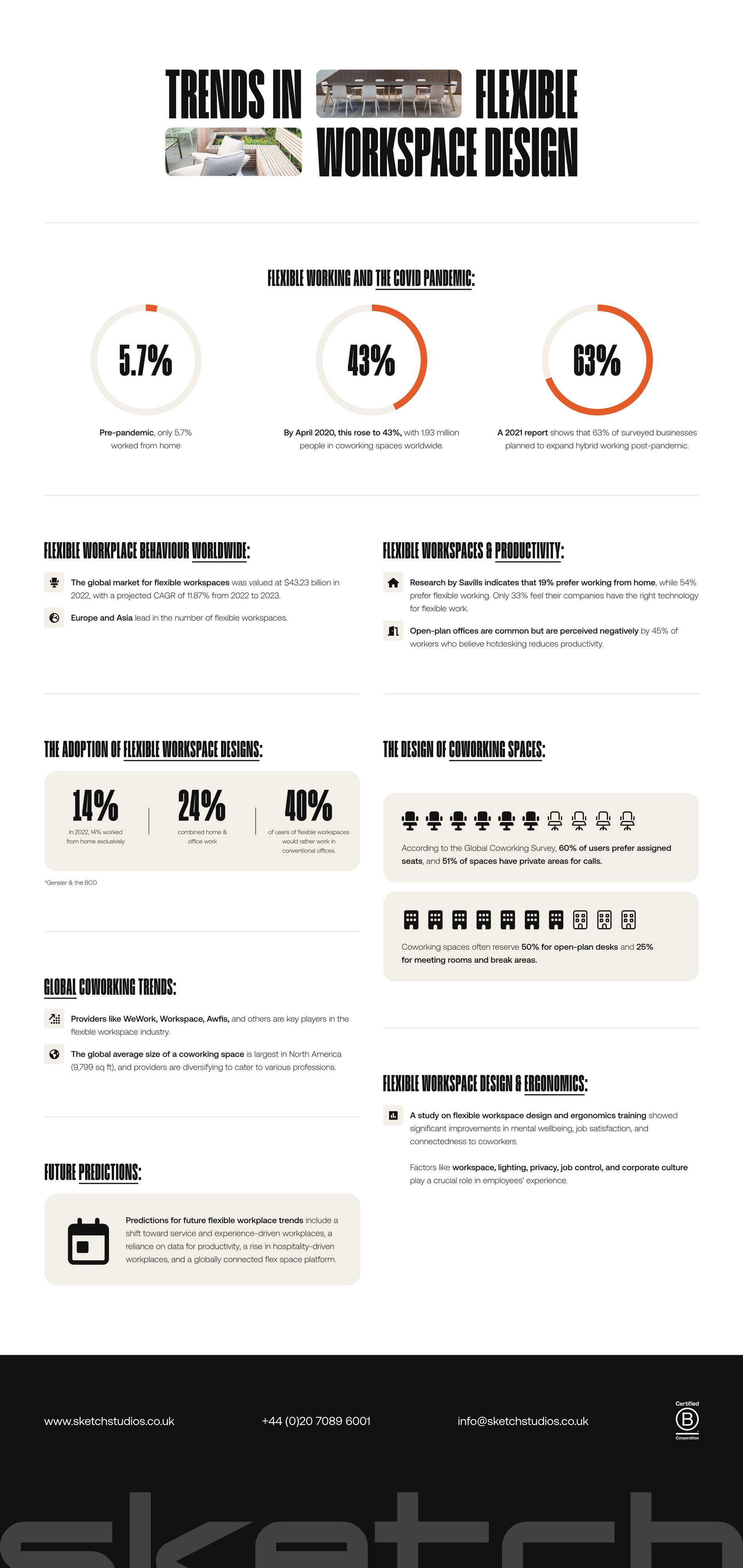
Top 5 Flexible Workspace Questions You Need to Know
1. What does flexible workspace mean?
A flexible workspace is a versatile work environment that can be easily adjusted to suit different tasks, team sizes, and work styles. It typically includes adaptable furniture, shared spaces, and technology that supports remote and hybrid working, allowing employees to choose how and where they work.
2. What is a flexible working area?
A flexible working area is a part of the office designed to support various work activities. It might include hot desks, quiet zones, collaborative spaces, and breakout areas. These spaces allow employees to select an environment that best fits their current work needs, whether for focused tasks, teamwork, or informal meetings.
3. Why is a flexible workplace essential in a modern organisation?
A flexible workplace is crucial in a modern organisation because it caters to diverse working styles, boosts employee satisfaction, and enhances productivity. It allows businesses to adapt to changes quickly, such as shifts in work patterns or team dynamics, and helps attract and retain talent by offering a work environment that meets contemporary needs.
4. What is the difference between a flexible workspace and a traditional office?
The main difference between a flexible workspace and a traditional office is adaptability. A flexible workspace is designed for change, with movable furniture and multipurpose areas that can be reconfigured as needed. In contrast, a traditional office typically has a fixed layout with assigned desks and private offices, offering less flexibility.
5. What is the difference between a flexible workspace and a coworking space?
A flexible workspace is an adaptable office environment within a single organisation, designed to meet the needs of its employees. A coworking space, however, is a shared environment used by people from different companies or freelancers, offering communal areas and resources that foster networking and collaboration across different fields.
Published on
November 29, 2023
